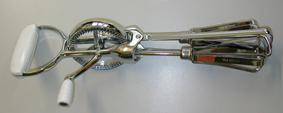| Approach: One
to one |
Level:
Year 4
and year 8 |
|
| Focus:
Investigating
and evaluating design |
| Resources:
Egg beater
|
 |
276kb |
|
|
| Questions/instructions:
Give student beater.
Here’s a tool that’s found in lots of homes. It’s
an egg beater and it’s used to beat different kinds of foods.
|
|
%
responses
2004 ('00) |
| y4
|
y8 |

|
|
|
| 1.
Show me how the egg beater works. |
not
marked |
• |
• |
Student
demonstrates.
The egg beater is made up of many different parts. Each part works together
with other parts to make the egg beater work. |
|
|
| 2.
Tell me what each part does. Point to each part as you talk about it. |
| 3.
Explain to me how it works — how the parts all help to make it work. |
top
handle – hold egg beater here |
78
(67) |
84
(72) |
crank
handle – makes beaters rotate |
95
(86) |
94
(91) |
large
cog – turns small cogs |
73
(68) |
84
(93) |
small
cogs – transmit rotation to beaters |
61
(58) |
79
(83) |
beaters
fit in bowl and beat food |
67
(47) |
73
(66) |
bent
rod at bottom supports beaters |
10
(9) |
18
(13) |
folded
metal surround – supports and gives operating clearance |
12
(10) |
28
(14) |
| Point
to beaters. |
|
|
|
| 4.
If you want these beaters to be able to spin around faster (not just by
turning the handle faster) what changes would you make to the way the
egg beater is made? |
|
|
change
gearing (general) |
3
(6) |
21
(20) |
increase
ratio of main cog teeth to small cog teeth |
3
(0) |
16
(21) |
other
workable idea, excluding electrical operation |
12
(9) |
17
(18) |
converting
to electrical operation |
49
(33) |
54
(53) |
| 5.
What materials is the egg beater made from? |
|
|
Metal: stainless steel |
7
(8) |
34
(33) |
steel
/ metal (general) |
91
(87) |
64
(67) |
Plastic:
mentions handles and cogs |
9
(7) |
9
(10) |
mentions
either handles or cogs |
78
(77) |
87
(88) |
| 6.
Why have these materials been used? |
|
|
prompt: |
What
is it about these materials that make them suitable for the egg beater? |
Stainless
steel: strong |
56
(50) |
62
(63) |
easy
to clean |
6
(9) |
22
(21) |
durable/does
not rust |
12
(10) |
35
(28) |
Plastic
handles: comfortable to hold |
34
(36) |
44
(44) |
easy
to clean |
3
(6) |
10
(8) |
durable
|
4
(2) |
7
(2) |
Plastic
cogs: durable |
0
(0) |
3
(2) |
quiet
|
0
(0) |
1
(1) |
Total
score: 14–22 |
0
(0) |
7
(2) |
12–13
|
4
(4) |
19
(12) |
10–11
|
18
(14) |
29
(42) |
8–9
|
35
(33) |
28
(25) |
6–7
|
29
(20) |
14
(15) |
0–5
|
14
(29) |
3
(4) |
Commentary
Predictably, students tended to focus on larger features rather than
smaller details, and on less technical ideas about materials and mechanisms.
About 30 percent more year 8 than year 4 students scored 10 or more.
For year 4 students, there was a marked reduction of very low performance
between 2000 and 2004, with little difference at higher performance
levels. For year 8 students, there was an increase in high performance
between 2000 and 2004, with little difference at low performance levels.
|